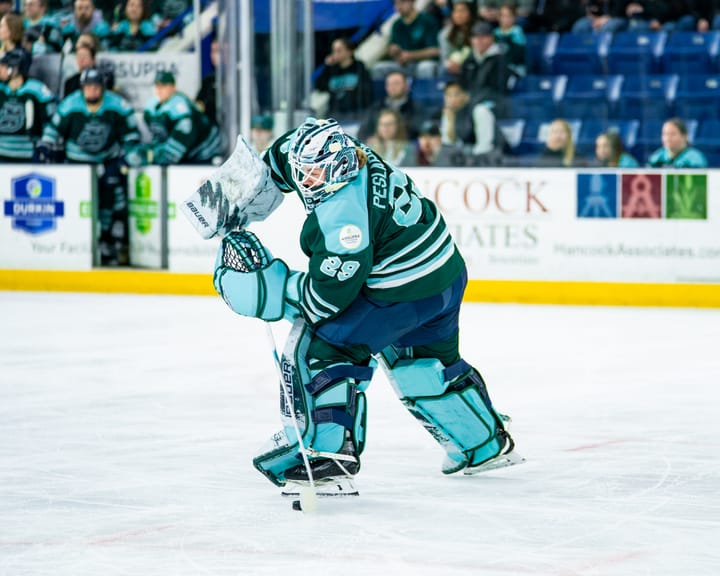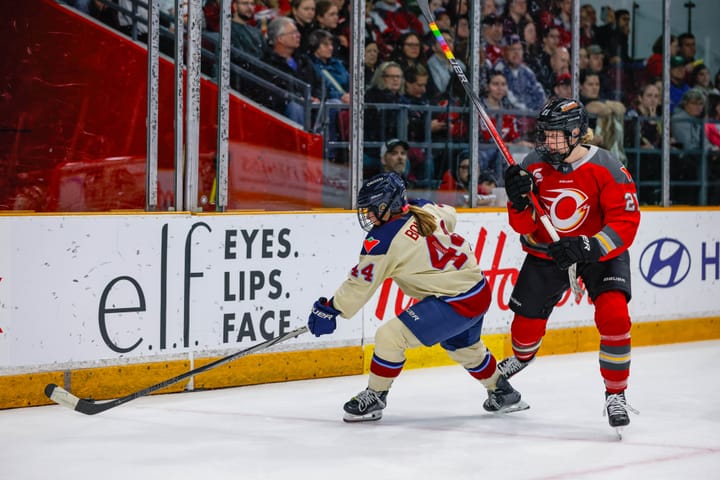The Takeaway: Disorder and disparity
Big wins for Bemidji State and RPI; plus, Phase II of the NCAA Gender Equity Report uncover disparities between men’s and women’s ice hockey
We’ve got some fun on-ice updates and some maddening off-ice updates for you in this week’s Takeaway.
5 Things to Know
Welcome, chaos, my old friend: I missed you. I really did.
Northeastern’s early season weekend sweep at the hands of Boston University and Providence sure felt like it might be the biggest shock of the season. We’ve had several more since then. On Saturday, in a wild day of underdog performances, we saw Bemidji State beat Clarkson, RPI shut out Providence, and Brown tie with Penn State. All three losing teams have been in the NCAA Tournament conversation to start the year; Providence and Clarkson in particular will likely be bubble teams, making these possibly disastrous losses.
What makes the results even more striking is that they came on the heels of close games on Friday evening, too. Clarkson and Bemidji State skated to a 1-1 tie in the first game of their series. Providence needed to come from behind in the third period to beat Union, 2-1, in their first game of the weekend. And still, their offenses struggled to convert on Saturday.
The Beavers have won just one other game this season and won a total of two all last season. RPI did not play the 2020-21 season and did not win a single one of their 34 games in 2019-20. Brown also missed last season and held a 3-23-3 record in 2019-20. These are notable results for programs that don’t get to see them come to fruition very often (RPI is receiving votes in the polls for the first time since 2009). While it likely won’t change the trajectory of their seasons, it is fun as heck to see the Engineers, Beavers, and Bears spicing things up early on.
🚨 GOAL! 🚨
— RPI Athletics (@RPIAthletics) October 23, 2021
Marah Wagner goes top shelf to double the lead! Her team-leading fourth goal of the year!#RPIHockey | #ECACHockey pic.twitter.com/oE0Q3Sz2kq
UConn skates to best start in program history: With a win over Merrimack on Friday, the Huskies are now 7-0-0 on the season, making this the best start for any UConn women’s hockey team.
The Huskies have yet to face off against a ranked opponent, but they’ve won a couple of important Hockey East matchups, most notably a 1-0 shutout victory over Maine two weeks ago. So far, senior goaltender Samantha Carpentier-Yelle is 3-0-0 in conference play, with a 1.67 goals-against average and .934 save percentage.
Their senior class has led the way so far; UConn is a team that is definitely benefitting from the extra year of eligibility due to the pandemic, with several very talented players electing to return for a fifth year. Both Morgan and Taylor Wabick are back, as well as Natalie Snodgrass; the Huskies also picked up Summer-Rae Dobson out of the transfer portal from Mercyhurst. Senior Viki Harkness leads the team with five goals and seven points in eight games.
UConn will put their streak to the test against Vermont and Merrimack this coming weekend, and then it’s on to a home-and-home with Boston University.
7-0✅
— UConn Women's Hockey (@UConnWHOC) October 22, 2021
Summer-Rae Dobson with the game winner! pic.twitter.com/NvsyyylGJi
Wisconsin remains undefeated: As anticipated, the Badgers hosted Ohio State last weekend for a No. 1 vs. No. 2 matchup in Madison. After a close series, they skated away with a sweep and retained full control of the top spot in the polls. In both games, the Buckeyes got off to a strong start, but their offense could never take full control. Wisconsin erased a 1-0 deficit on Saturday to win, 3-1.
On Sunday, the Badgers scored first and the Buckeyes tied it up before the end of the period. The rest of the game, goaltenders Kennedy Blair and Andrea Brändli put on a show. Each made 23 saves in regulation to force overtime.
Once in the extra period, it was Nicole LaMantia’s time to shine for the Badgers. Here’s a look at her game-winner:
Nicole LaMantia called game!
— NCAA Ice Hockey (@NCAAIceHockey) October 25, 2021
Thanks to a pair of goals from senior @nicolelamantiaa, No. 1 Wisconsin earned a 2-1 overtime victory against No. 2 Ohio State on Sunday. #NCAAHockey x 🎥 @BadgerWHockey pic.twitter.com/cYIb2iRBcL
She’s been great in close matchups the last few weeks for Wisconsin. She scored both goals for the team in Sunday’s win, and netted an important go-ahead goal for the Badgers in the third period against Minnesota Duluth two weeks ago, which helped the team stay tied at 4-4 after regulation and, eventually, win in overtime there as well.
Minnesota earns a sweep over Colgate: Last weekend actually featured not one but two top-five matchups, with then-No. 3 Colgate hosting then-No. 4/5 Minnesota. The Gophers earned an important sweep on the road, beating the Raiders 5-3 and 3-2 on Friday and Saturday.
It was an emphatic performance in two key non-conference games for Minnesota, and it earned them the No. 3 ranking in the polls this week. Their success this season is coming in a slightly unconventional way; they’re missing crucial pieces in Abbey Murphy and Grace Zumwinkle to USA Hockey centralization, and they have just one player ranked in the top 25 nationally in scoring (though, of course, it’s still early yet). Since an early-season sweep to Ohio State, the Gophers have found balance throughout their lineup, including in net; Makayla Pahl and Lauren Bench were both solid in their starts against the Raiders.
Phase II of the External NCAA Gender Equity Review is released: And, not shockingly, contains damning evidence of inequities and disparities in the way the NCAA treats the sports of men’s and women’s ice hockey, particularly each sport’s national tournament.
The full report uncovered a trend that directly impacts women’s hockey: sports in which one championship are perceived as significantly more revenue-producing than its “gender counterpart” are actually more likely to feature inequitable player experiences.
Today, the only championships that the NCAA considers revenue-producing are men’s championships: Division I baseball, men’s basketball, men’s ice hockey, men’s lacrosse, and wrestling. It is when those sports have women’s counterparts that we observed the greatest resource disparities and resulting gender inequities.
(Quick note on language here: While the NCAA divides sports up into men’s and women’s sports, and the report in turn uses the same binary language, we know that folks of all marginalized genders play women’s hockey, including NCAA women’s hockey. The inequities at play here do not just affect cis women, and it’s important to acknowledge that.)
Here are some highlights (lowlights? lowlights.) of the specifics of the ice hockey case study section of the report, conducted by Kaplan, Hecker, and Fink, found:
- Because the men’s championship is held in NHL arenas and the women’s championship is held in campus arenas with much smaller attendance capacities, the potential for revenue generation is starkly contrasted. In 2019, the men’s championship brought in $5.84 million; the women’s championship brought in $154,189.
- The NCAA spends almost four times as much on signage at the men’s championship as the women’s championship.
- The men’s Frozen Four gets a fan fest, with the ability to sell corporate sponsorships; the women’s Frozen Four gets no such thing.
- The NCAA spends $193,000 on promotional expenses for the men’s tournament each year and $11,000 for the women’s tournament.
- Overall, the NCAA spent about $4.2 million on the 2019 men’s tournament and $656,827 on the women’s tournament.
- That translates to a $9,805 cost per athlete for the men’s tournament and a $3,421 cost per athlete for the women’s tournament.
- There are 11 staff members who contribute to planning the men’s tournament. There are just two who contribute to planning the women’s tournament.
- The percentage of teams competing in the men’s tournament is higher than the women’s tournament: 26.7% vs. 19.5%.
- Even on individual teams, fewer women’s hockey players are allowed to compete at the championship. Teams in women’s hockey can only roster 24 players, whereas men’s teams can roster 27. I mean, for what reason? Is it just to keep me up at night, thinking about this player?/
One women’s ice hockey coach told us about a student-athlete who was not allowed to play due to championship squad-size constraints: “[S]he was heartbroken and in tears that she had worked so hard and none of it would be recognized.”
The Phase II review also very clearly spelled out the obvious inequities in how the ice hockey tournament brackets are constructed. Anyone who has spent 10 minutes paying attention to college hockey in March knows this, but the women’s field features eight teams, and the top four are seeded. The bracket is then designed exclusively to minimize air travel. First-round pairings are set to work in as many bus trips as possible to save money. Bracket integrity is literally a secondary priority.
There is, of course, no such criteria for the men’s bracket formation. No instruction to reduce travel costs. Instead, the men’s tournament bracket gets to prioritize “competitive equity, financial success[,] and the likelihood of a playoff-type atmosphere at each regional site.”
Bracket integrity is literally a secondary priority.
This part of the review is the least surprising and yet the most infuriating. There is no time of year I love more than the NCAA Tournament. I patter along in my extremely dull existence for about 357 days of the year just for the fun of witnessing triple overtime games, wild comebacks and upsets, historic wins for up-and-coming programs, and players scoring their first goals of the year to win championships for their teams.
And all of it could be even better if bracket integrity was assured year in and year out. Instead, we basically never get the most competitive bracket possible. It’s spelled out right in the championship manual for all the world to see. The NCAA did not need a third-party to bring this to their attention. It’s in their own damn rule book.
Is it any wonder that the NCAA men’s hockey championship generates revenue while the women’s hockey championship does not, with exponentially more resources and a structure designed to produce the best product for fans, instead of the cheapest? I guess I’m left wondering, as always, how a “non-revenue-generating” sport is ever supposed to become one when its potential is so succinctly tied down by a paltry budget, hidden from wider audiences, and handcuffed to the seat of a rented charter bus, trekking along the interstate.
Don’t Miss It:
Upcoming games to watch for:
Boston College vs. Northeastern, home-and-home, Friday, Oct. 29, and Saturday, Oct. 30: This will of course be a key set of games in the Hockey East race between longtime conference foes. The Huskies, despite all their talent, have not quite looked like their dominant selves this season; still, this is a big test for the Eagles and their 6-0-0 record so far.
Cornell vs. Harvard, Friday, Oct. 29: Two intriguing ECAC teams will hop right back into Ivy League action after last season was canceled due to COVID. Cornell is coming off a split with Mercyhurst, while the Crimson won their first game, 6-2 over Saint Anselm. There are still some pretty big questions for both teams to address after a full season without games; we’ll see how they stand after this one.
Penn State at Mercyhurst, Friday, Oct. 29, and Saturday, Oct. 30: The Lakers so far look like the team to beat in the CHA, with a big win over Cornell added to their resume last week. The Nittany Lions, meanwhile, are struggling to find the same groove they had last season and translate it to their non-conference schedule. A series against another strong CHA team is just the time to show that they’re a contender again this year.





Comments ()